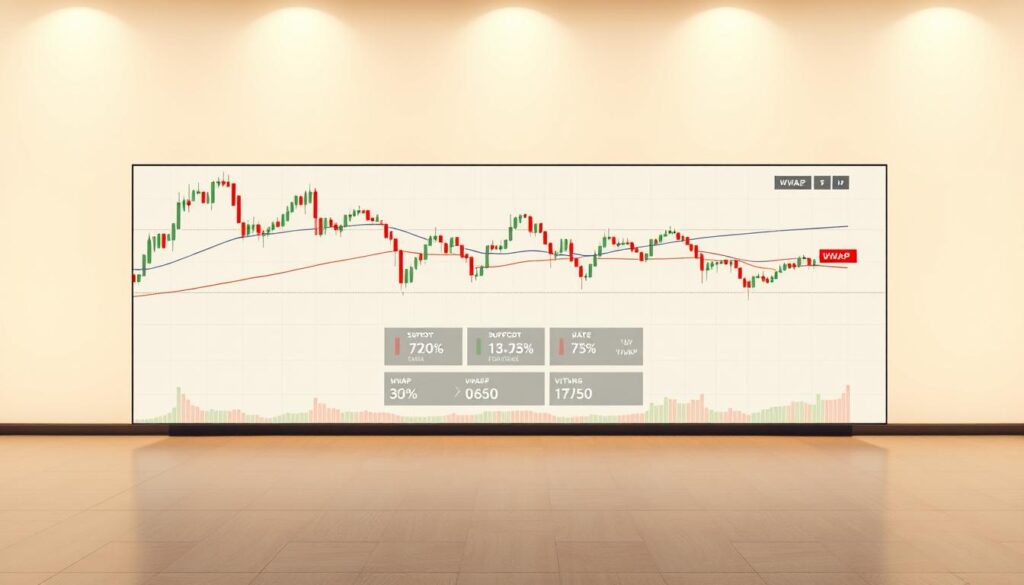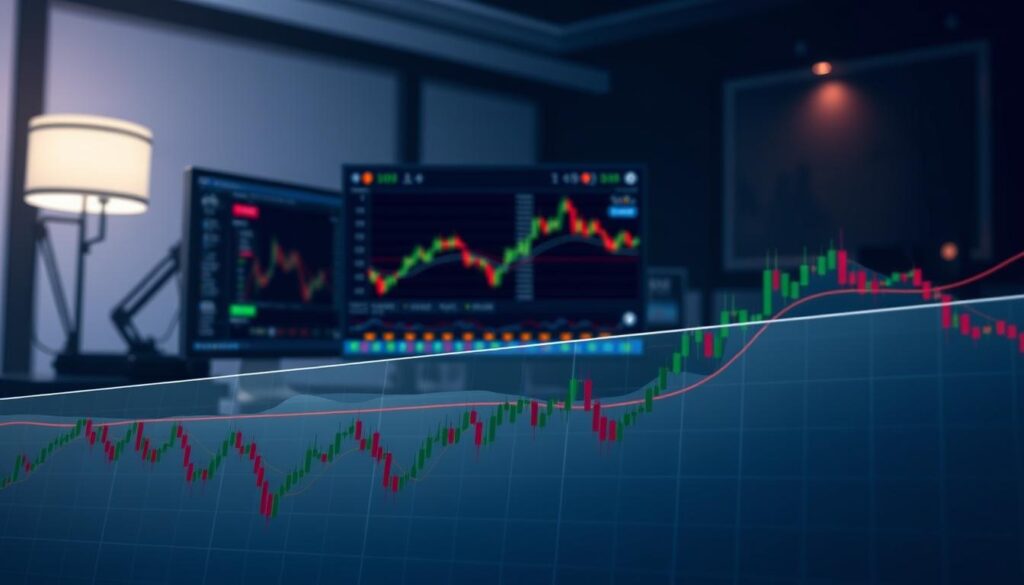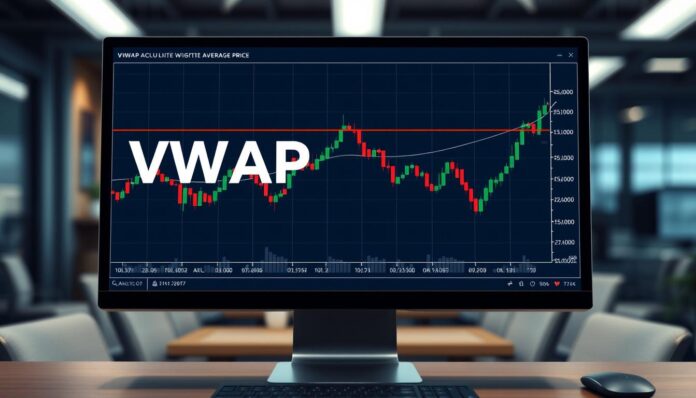Swing traders often debate whether the Volume Weighted Average Price (VWAP) is a useful tool for their strategies. This article explores is vwap good for swing trading by analyzing how this indicator performs beyond its common use in intraday markets. Many traders wonder if VWAP’s real-time price insights can help capture profitable trends over days or weeks.
Readers will discover how VWAP balances price and volume data to highlight support/resistance levels. We’ll compare its effectiveness for short-term holds versus fast-paced day trading. The goal is to clarify if is vwap good for swing trading depends on specific market conditions or timeframes.
Key Takeaways
- VWAP combines price and volume to show average market levels.
- Swing traders use it to spot trends lasting longer than a single trading session.
- Its effectiveness varies based on market volatility and asset liquidity.
- Combining VWAP with other tools like moving averages can improve accuracy.
- Understanding VWAP’s limitations prevents overreliance on a single indicator.
Understanding VWAP and Its Purpose
Traders often seek tools to interpret market trends accurately. The vwap indicator, or volume weighted average price, offers a dynamic way to track price and volume interactions. Let’s break down this essential concept.
What is VWAP?
VWAP is a technical indicator that calculates the average price at which a security has traded, weighted by its trading volume. This means periods with higher trading activity influence the average more than quieter periods. Think of it as a balance point between buyers and sellers. As a trader, this line acts as a reference for fair value during a specific timeframe.
How is VWAP Calculated?
The vwap formula uses three components: price, volume, and time. Here’s how it works:
- For each time period (e.g., 1 hour), multiply the period’s average price by its volume.
- Sum these values across all periods.
- Divide by total volume to get the VWAP value.
“VWAP isn’t just a line on a chart—it’s a real-time snapshot of market sentiment,” says market analyst Sarah Lin.
Importance of VWAP in Trading
Institutional traders rely on VWAP to execute large orders without disrupting prices. When the market price moves above VWAP, it signals buying pressure; below suggests selling. Retail traders can use this to spot trend shifts. By combining volume and price data, VWAP provides clearer insights than basic moving averages.
Key Benefits of Using VWAP
VWAP delivers actionable advantages for traders. By integrating the vwap trading strategy into swing trading strategies, traders gain clear insights. Let’s explore how these benefits translate into real-world results.
Identifying Trends
VWAP acts as a dynamic line that adapts to market activity. When price stays above VWAP, it signals bullish momentum. Below VWAP points to bearish trends. This makes spotting trends intuitive. Here’s how it works:
- Prices above VWAP = buy-side dominance
- Prices below VWAP = sell-side dominance
Establishing Entry and Exit Points
Use VWAP crossovers to time entries and exits. For example:
| Method | Entry Signal | Exit Signal |
|---|---|---|
| Traditional | Breakouts or support/resistance levels | Fixed timeframes or arbitrary price levels |
| VWAP Strategy | Price crossing above VWAP (buy) or below VWAP (sell) | Crossovers signaling trend exhaustion or reversals |
Minimized Risk
VWAP reduces emotional trading. It highlights fair-value zones, helping traders avoid chasing highs or panic-selling lows. For instance, entering when price retraces to VWAP lowers overpaying risks. Exit decisions become data-driven, cutting impulsive moves. These features make it a cornerstone in risk-aware swing trading strategies.
VWAP vs. Other Indicators
Choosing the right swing trading indicators depends on understanding each tool’s strengths. The volume weighted average price (VWAP) stands out by blending price and volume data, but how does it compare to classics like moving averages or momentum oscillators?
Comparisons with Moving Averages
Unlike simple moving averages (SMAs) or exponential moving averages (EMAs), VWAP factors in volume alongside price. This makes it more reactive to large trades, which matter most in fast markets. For example, during a breakout, VWAP shifts faster than a 50-day SMA because it weights price changes by traded shares. Traders using vwap day trading strategies often pair it with short-term EMAs to balance speed and trend clarity.
Differences from RSI and MACD
- RSI measures overbought/oversold levels, while VWAP shows where buyers and sellers meet.
- MACD highlights momentum shifts, whereas VWAP acts as a dynamic support/resistance line.
These distinctions matter: combining VWAP with RSI or MACD creates layered analysis, avoiding overreliance on a single metric. For instance, a divergence between MACD and VWAP might signal a pending reversal.
Remember, no indicator is perfect. VWAP resets daily in vwap day trading, so it’s less useful for multi-day swing trades. But its real-time volume insights make it a standout among swing trading indicators when used contextually.
VWAP’s Role in Swing Trading
When evaluating is vwap good for swing trading, many traders highlight its ability to reveal institutional buying or selling momentum across days. This data-driven line helps identify zones where price struggles or accelerates, making it a key tool for multi-day strategies.

Why Swing Traders Use VWAP
Swing traders rely on VWAP to spot support and resistance over 3–5 days. The line acts as a gravity point, showing where institutional orders cluster. For example, prices above VWAP often signal bullish trends, guiding entries and exits without daily noise.
Timeframe Considerations
Traditional VWAP resets daily, complicating multi-day analysis. Here’s how traders adapt:
- Use anchored VWAP to calculate lines over weekly or monthly periods.
- Combine with weekly charts to spot major shifts in market sentiment.
- Pair with volume spikes near VWAP zones for confirmation.
A robust vwap trading strategy adjusts these methods, balancing daily resets with longer-term signals. While it’s not a standalone tool, its insights into institutional activity make it a valuable part of swing setups.
How to Incorporate VWAP in Your Strategy
Mastering the vwap indicator starts with chart setup. Most platforms like TradingView or MetaStock offer customizable settings. Begin by selecting your preferred timeframe—daily or weekly charts work best for swing trading strategies. Adjust line thickness and colors: use red for bearish zones above price action and green for bullish support below.
Setting Up Your Charts
- Choose a 20-period VWAP setting for short-term swing trades
- Overlay price action with both the VWAP line and its 50-period moving average
- Use alerts to notify when price crosses the VWAP zone
| Platform | Steps |
|---|---|
| Thinkorswim | Navigate Studies → Add Study → Volume Weighted Average Price |
| MetaTrader | Install via Market Wizard: “VWAP” in indicator library |
Combining VWAP with Other Indicators
Pair the vwap indicator with momentum oscillators like RSI. When price hits VWAP resistance and RSI shows oversold conditions (below 30), this creates a potential buy signal. Here’s how to layer indicators effectively:
- Draw trendlines connecting recent swing highs/lows
- Use Bollinger Bands to identify volatility clusters around VWAP zones
- Backtest setups using historical price action charts
Professional swing traders often combine VWAP with price action patterns. For example, a pin bar rejection from the VWAP line signals strong support/resistance. Always validate signals with volume analysis—high-volume days near VWAP zones indicate higher reliability.
Common Misconceptions About VWAP
Like any tool in your trading toolkit, VWAP isn’t a one-size-fits-all solution. Many beginners mistakenly believe it’s a swing trading indicators “silver bullet.” Let’s debunk these myths to set realistic expectations.
VWAP Isn’t the “Holy Grail”
Some traders wrongly assume VWAP guarantees profits. In reality, it’s just one piece of the puzzle. Effective strategies require combining it with other tools like volume analysis or trend lines. Relying solely on VWAP can lead to overconfidence—market conditions often demand flexibility.
Limits and Drawbacks
- Low Volume Traps: VWAP struggles in thinly traded stocks where liquidity gaps distort its calculations.
- Price Volatility: Rapid price swings can make VWAP lag behind real-time trends, creating misleading signals.
- Sector Variability: Its accuracy varies across industries—small-cap stocks behave differently than blue-chip equities.
Remember, no single indicator is flawless. Pair VWAP with other swing trading indicators and always test strategies in demo accounts. As trader legend Paul Tudor Jones said:
“The market’s only constant is change—adapt or get left behind.”
By acknowledging these limitations, traders avoid overreliance on any single tool. VWAP’s true value lies in its role as part of a balanced strategy—not a standalone miracle solution.
Case Studies: VWAP in Action
Let’s look at real-world scenarios where the VWAP trading strategy worked—or didn’t. These case studies highlight how market conditions affect results.
Historical Examples of Successful Trades
Successful trades often align with core vwap trading strategy principles:
- Mean Reversion in AAPL Shares: In early 2023, Apple’s stock dipped 4% below its 20-day VWAP. Swing traders using mean-reversion techniques bought at the gap, profiting as price rebounded to VWAP support.
- Trend Confirmation in TSLA: Tesla’s price stayed above its 10-day VWAP for three weeks in 2022. This signal aligned with swing trading techniques focused on trend continuation, leading to a 12% gain over two weeks.
Lessons from Unsuccessful Trades
Failures often arise when ignoring volume or external factors:
- News-Driven Collapse: During a 2021 earnings miss, a retail stock crashed below VWAP but didn’t rebound. High volume from panic selling overwhelmed the indicator’s signals.
- Low Volume Traps: In thinly traded small-caps, VWAP lines became unreliable. Traders relying on standard swing trading techniques here faced losses when price ignored VWAP levels.
“VWAP isn’t a crystal ball. It’s a tool that needs context—like volume spikes or news events—to avoid costly mistakes.”
These examples show how combining swing trading techniques with market context maximizes the vwap trading strategy’s value. Always pair signals with volume analysis and news calendars for better outcomes.
Tips for New Traders Using VWAP
Mastering VWAP requires more than just understanding its calculations. New traders should focus on building habits that turn theory into profit. Here’s how to structure your approach effectively:

Developing a Trading Plan
Start by outlining clear swing trading strategies that align with VWAP signals. Use these steps to create a roadmap:
- Set fixed rules for entries, like buying when price crosses above VWAP with high volume.
- Define exit points, such as trailing stops below VWAP or profit targets based on volatility.
- Incorporate risk management—aim for 1-2% risk per trade in your swing trading techniques.
Importance of Backtesting
Before risking capital, test your ideas using historical data. Follow these steps:
- Simulate 10-20 trades on past charts to see where VWAP signaled winners or losers.
- Adjust your strategy when results fall below 50% success rates or risk-reward ratios below 1:2.
- Use free platforms like TradingView to practice without real money.
“Backtesting isn’t optional—it’s how winners learn to lose virtually, not real cash.” – Professional Trader
Consistency and patience are key. Stick to your plan even during drawdowns. Remember: successful swing trading strategies evolve through trial and refinement.
Analyzing Market Conditions with VWAP
Market direction shapes how traders use the vwap trading strategy. Let’s break down its application in trending and range-bound environments.
Bullish vs. Bearish Trends
- In bullish trends, VWAP lines slope upward. Prices hugging above VWAP signal strong momentum.
- Bearish trends show downward-sloping VWAP. Prices below the line confirm downward pressure.
Sideways Market Applications
In sideways markets, VWAP acts as a dynamic midpoint. Breakouts above or below VWAP lines can signal trend reversals. For example, when price repeatedly fails to break VWAP, it strengthens support/resistance levels.
| Market Condition | VWAP Behavior | Action |
|---|---|---|
| Bullish | Price stays above rising VWAP | Look for pullbacks to VWAP as entry points |
| Bearish | Price remains below falling VWAP | Exit longs when price closes below VWAP |
| Sideways | Price oscillates around VWAP | Watch for volume spikes near VWAP for breakout signals |
“Sideways markets demand patience. VWAP helps traders wait for high-probability breakouts instead of guessing.” – Market Analyst, TradePro Insights
Adapting your vwap trading strategy to current conditions reduces guesswork. For instance, in choppy markets, combining VWAP with volume analysis (as seen in penny stock analysis) highlights hidden opportunities. Always pair VWAP with other tools like RSI or moving averages for confirmation.
Conclusion: Is VWAP Right for You?
Deciding if is vwap good for swing trading depends on your unique approach. VWAP isn’t a one-size-fits-all tool, but it offers distinct advantages for specific strategies.
Suitability for Different Trading Styles
Traders focused on institutional flows or volume analysis often find VWAP indispensable. It highlights key levels where large orders execute, aligning with swing strategies that target medium-term trends. However, those relying purely on candlestick patterns might find VWAP less critical. Consider your priorities:
- Institutional traders: Benefit from VWAP’s volume-based signals
- Time-constrained traders: Use VWAP as a core filter for entries/exits
- Price-action purists: May prefer alternative indicators
Final Thoughts on VWAP and Swing Trading
VWAP excels when paired with other tools like RSI or moving averages. It’s not a standalone solution but a powerful layer of analysis. Test its impact through backtesting—compare trades with and without VWAP signals. Remember, success hinges on aligning it with your:
“VWAP isn’t a crystal ball—it’s a roadmap. Follow it wisely.”
Ask yourself: Does volume-based decision-making fit your workflow? If yes, VWAP can enhance your swing trades. If not, explore alternatives that better match your style.
Whether is vwap good for swing trading remains a personal choice. Start small, track results, and adapt. Every trader’s path is unique, and VWAP could be your next strategic asset—if used thoughtfully.
FAQs About VWAP
Many traders ask how to apply the vwap indicator effectively. Here are answers to the most common questions:
What Are Practical VWAP Strategies?
- Trade reversals when price moves 2-3% away from the vwap line.
- Use crossovers (price above/below VWAP) to confirm trend direction.
- Combine with volume analysis to spot potential breakouts.
Can VWAP Work for Day Trading?
Yes! The vwap formula resets daily, making it ideal for vwap day trading. Compare its use in different styles:
| Aspect | Day Trading | Swing Trading |
|---|---|---|
| Timeframe | 1-day period | 2-3 day periods |
| Key Use | Intraday support/resistance | Midterm trend assessment |
How Often Should Traders Check VWAP?
- Day traders: Check every 1-2 hours during active sessions
- Swing traders: Review at market open/close
- Adjust based on volatility (check more during earnings or news events)
Remember, the vwap formula calculates using current session data. Always pair it with other tools like RSI or volume profiles for confirmation.
Resources for Further Learning
Deepening your knowledge of VWAP and its role in swing trading means exploring trusted resources. These options offer practical guidance on mastering swing trading indicators and refining techniques to enhance your strategy.
Books for Mastering VWAP and Swing Trading
Start with Technical Analysis of the Financial Markets by John J. Murphy, which covers foundational swing trading indicators and their application in real markets. For VWAP specifics, Trading with the Odds by Mark D. Fisher explains volume-based strategies, including how VWAP interacts with price trends. Alexander Elder’s The New Trading for a Living reinforces disciplined techniques, aligning with VWAP’s role in minimizing risk—a key swing trading principle.
Online Courses and Webinars
Platforms like TradingView and Investopedia offer courses that blend theory with practice, focusing on swing trading techniques using tools like VWAP. Perry Kaufman’s Trading Systems and Methods webinar series on Investopedia explores volume-weighted analysis in depth. Udemy hosts courses like Mastering Swing Trading, which includes modules on combining VWAP with moving averages. Many brokers, including TD Ameritrade, provide free webinars on advanced technical analysis techniques.

